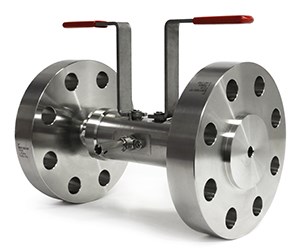With the advent of the oil, gas and chemical manufacturing industries came the need to safely isolate plant sections for maintenance and repair. An initial approach was simply to remove pipe sections and insert blanking flanges. The downside is that the pressure has to be vented first. A faster, safer technique was to use a valve assembly comprising two isolation valves with a vent between them. This enabled operators to shut off the pressure and demonstrate that a block had been achieved.
In the event of the upstream valve leaking this could be safely removed via the vent with the second valve providing an additional barrier. This arrangement of valves became known as a double block and bleed (DBB) assembly. However, including two valves in a pipeline together with a vent, drain and pressure monitoring connections introduced complexity and several potential leak paths.
It was not until the mid-1980s, following some high-profile disasters, that the concept of the modular double block and bleed valve (Modular DBB) became established. As HSG 253 on the Safe Isolation of Plant notes, a DBB provides a “proved isolation” which is second only in terms of security to “positive isolation” – physically removing pipe and blanking with a flange. This construction integrated all three valves in one housing, thereby reducing weight, cost and potential leak paths.
Innovations
Single valves can also offer a double block and bleed function. However, this is where terminology becomes confusing, as DBB means different things to different people. It cannot be used unambiguously unless a definition or standard is also quoted. Additional terms have been coined: Double Isolation and Bleed (DIB, API 6D) and Double Barrier and Bleed (Norwegian Oil and Gas, 2013), recommended in preference to “double block and bleed” due to the potential misunderstanding of the latter term.
Many authors have sought to clarify this subject. On the one hand we have a single valve with two seats that seals with pressures from opposite directions and on the other, two seats that seal from the same direction (DBB and DIB respectively according to API 6D definitions).
The OSHA Federal regulation describes DBB as “the closure of a line, duct or pipe by closing and locking, or tagging, two in-line valves and by opening … a drain or vent valve in the line between the two closed valves.”
Clearly the capability of the valve or combination of valves depends on the valve type and design; different valves will have different capabilities and associated costs. To distinguish a single valve from multiple ones, the inclusion of the word “modular” helps. Understanding the design and type of valves included (floating, downstream sealing ball valves or trunnion, upstream sealing ones) will then provide an indication of the further capabilities.
As the technology and concept became established, manufacturers began to introduce innovations. Most of these were concerned with squeezing three valves into the standard face-to-face dimensions of a single valve, thereby allowing the replacement of one valve with a modular implementation of three.
Infinite variations
It is also important to consider the variety involved in a modular valve. There are three valves: the specifications of all three need to be considered, therefore the variety of potential combinations is simply staggering! Assume there are six basic process valve bore sizes to choose from, something like eight formats of valves (ball, ball, ball; ball, needle, ball etc.), eight pressure classes (up to 10,000 PSI), six types of connection (flange RF, RTJ, hub, welded etc.) as well as six possible sizes on both inlet and outlet, plus a variety of vent connection types and sizes (say 15).
We’re now up to 7.4 million combinations before even considering materials. If we limit body, trim, seat, seals and bolting to 6 variations each (65=7,776 variations) we now have 58 billion possible combinations. It doesn’t stop there: material selection, NDE (the scope is unlimited), painting, special testing and so on. It’s hardly worth doing the calculations – for all practical purposes the number of variations can be considered infinite.
Knock-on effect
True, some combinations are unlikely, but the customised material specifications that are often required have not been considered either. In conclusion: the chances of having an existing configuration that matches new requirements are extremely low. Therefore valves are tailor-made, whereby the components required are unlikely to be in stock and almost certainly additional design work will be needed. This has a knock-on effect on lead-times and costs. The Alco XC range of valves was designed to address these issues. By using the concept of delayed customisation, some of the variation can be postponed in the production cycle which helps to deliver a degree of standardisation.
The concept is to manufacture, build and test a standardised central section that houses all the valves. This central section is self-contained with its own integral ends and tested as a stand-alone unit without pipe end connections. These are added as a final operation. In terms of order fulfilment, if the central cartridge is in stock all that needs to be manufactured are the end connections – a matter of days. Taking the concept further, cartridges can be stocked around the globe and the finalisation process can be done locally, removing the need for shipping as well. Some compromises are necessary. A standardised format and selection of materials is needed. Offering carbon steel, stainless steel and duplex (LF2, F316 & S31803) together with a standardised trim of PEEK seats, FKM O-rings and duplex ball and stem should cover most requirements.
There are additional benefits to standardising the design: the essential valve qualifications (fugitive emission, fire test, PR2, TAT, etc.) for the complete range can be done without too much difficulty. Focusing on the basis of the design and perfecting the core functionality allows good coverage of the major qualification tests to be obtained up-front.
Conclusion
The benefits of this patent-applied-for technology are lower prices and faster availability due to (i) standardisation of the core valve and (ii) postponement of the bulk of the variation to the last possible moment. With three basic material combinations and five bore sizes, the variations are significantly reduced to only around 117,000.
This is well within the capability of an ERP configurator and the result is a bespoke product available within days. The safety of a proved isolation device can now be provided within a timescale and cost to make alternative dangerous compromises a thing of the past.
About the Author
Eur. Ing. Ron Strang CEng FIMechE MBA, graduated as a Mechanical Engineer from Aston University in 1981 and from Hull University with an MBA in 2007. He has worked in the design and development of valves since 1981 and is currently Technical Director of Alco Valves in Brighouse.







